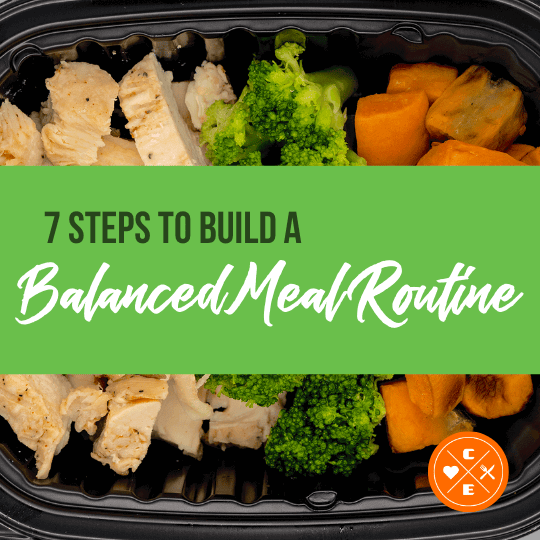
7 Steps to Build a Balanced Meal Routine
Jason Nista
Nutrition
|
Healthy Lifestyle
7 minute read
Table of Contents
Creating a balanced meal routine is about eating portion-controlled meals at the right times with a variety of foods. Here's how you can do it:
- Balance your plate: Fill half with vegetables/fruits, a quarter with lean protein, and a quarter with whole grains.
- Include key food groups: Lean proteins, complex carbs, healthy fats, fruits, vegetables, and dairy or alternatives.
- Stay hydrated: Drink 8–10 cups of water daily.
- Meal planning tips:
- Understand your nutritional needs.
- Plan meals weekly.
- Control portions with visual guides or pre-portioned meals.
- Add variety to avoid boredom.
- Include all food groups in every meal.
- Batch cook for busy weeks.
- Monitor and adjust based on what works for you.
Whether cooking at home or using meal delivery services, consistency and preparation are key to maintaining healthy eating habits.
My 6-Step Framework for Eating a Balanced Diet
What Makes a Balanced Meal
Understanding how to create balanced meals can help you build lasting, healthy eating habits that fuel your body effectively.
Main Food Groups
A well-rounded meal includes a mix of foods from these key categories to provide all the nutrients your body needs:
- Lean Proteins: Options like chicken breast, fish, lean beef, tofu, or legumes supply amino acids essential for muscle repair and maintenance.
- Complex Carbohydrates: Whole grains such as quinoa, brown rice, or whole wheat bread offer long-lasting energy and are rich in fiber.
- Healthy Fats: Sources like olive oil, avocado, or nuts aid in nutrient absorption and support brain health.
- Fruits and Vegetables: Fill a significant portion of your plate with colorful produce to pack in vitamins, minerals, and antioxidants.
- Dairy or Alternatives: Low-fat milk, yogurt, or fortified plant-based alternatives provide calcium and vitamin D for bone health.
Plate Portions Guide
An easy way to balance your meal is by visually dividing your plate into sections:
| Plate Section | Portion Size | Example Foods |
|---|---|---|
| Vegetables/Fruits | ½ plate | Leafy greens, carrots, berries |
| Lean Protein | ¼ plate | Grilled chicken, fish, beans |
| Whole Grains | ¼ plate | Brown rice, quinoa, whole wheat pasta |
Water and Hydration
Staying hydrated is just as important as eating balanced meals. Water helps with digestion and nutrient absorption. Follow these simple tips:
- Aim for 8–10 cups of water daily.
- Drink 1–2 cups with each meal.
- Increase your intake during exercise or in hot weather.
Clean Eatz Kitchen makes it even easier to stick to these principles by offering pre-portioned meals. These meals are designed to include the right mix of proteins, complex carbs, and vegetables, helping you stay consistent with your healthy eating goals.
Now that you know the basics, let’s dive into practical ways to improve your meal planning.
sbb-itb-1989a25
7 Steps to Better Meal Planning
Use these steps to simplify meal planning and maintain a balanced routine.
Step 1: Understand Your Needs
Start by identifying your nutritional requirements based on factors like age, weight, activity level, and any dietary restrictions. For example, Clean Eatz Kitchen offers meal plans tailored to keto, high-protein, and gluten-free diets [1].
Step 2: Create a Weekly Schedule
Plan your meals around your weekly commitments, including work, exercise, and family time. If your schedule is packed, consider adding pre-made meals to save time. Clean Eatz Kitchen's meals can be stored in the freezer for up to 12 months, making them a convenient option [1].
Step 3: Manage Portions Wisely
Keeping your portions in check is key to a balanced diet. Here are some simple ways to do it:
| Method | How It Works | Example |
|---|---|---|
| Visual Reference | Compare to objects | Protein = palm size |
| Kitchen Scale | Measure precisely | 4–6 oz lean protein |
| Pre-Portioned Meals | Ready-to-eat sizes | 8–10 oz total per meal |
Step 4: Add Variety to Your Diet
Switch up your choices of proteins, grains, and vegetables to keep meals interesting and nutritionally diverse [1].
Step 5: Include All Food Groups
Aim for a mix of protein, complex carbs, and vegetables in every meal. Clean Eatz Kitchen's pre-portioned meals are a great example of this balanced approach [1].
Step 6: Batch Cook for Efficiency
Set aside a few hours on the weekend to prepare meals for the week. Batch cooking saves time and ensures you stick to your plan. On particularly busy weeks, having frozen meals as a backup can help you avoid less healthy options.
Step 7: Monitor and Adjust
Keep track of which meals work best for your schedule, energy levels, and taste preferences. Use that information to tweak your plan as needed.
Tips for Long-Term Success
Smart Eating Habits
Building healthy habits that last requires more than just willpower. It's about creating routines that fit your lifestyle. Start with mindful eating - enjoy your meals without distractions. This simple practice can help you better understand when you're hungry or full.
For those hectic days, having practical meal solutions ready can make all the difference.
Quick Meal Solutions
Life gets busy, but that doesn't mean your nutrition has to suffer. Here are some practical strategies to keep your meals balanced and stress-free:
| Time-Saving Strategy | Benefits | How to Do It |
|---|---|---|
| Meal Prep Sundays | Cuts down weekday cooking | Cook proteins and veggies in bulk |
| Strategic Freezer Use | Keeps meals fresh longer | Freeze single portions for easy use |
| Prepared Meal Service | No prep or cooking required | Opt for pre-portioned, balanced meals |
A Clean Eatz Kitchen customer shared their experience:
"Clean Eatz Kitchen has supported my weight loss journey and helped instill great habits - I've lost over 20 lbs this year and always enjoy their menu of delicious, convenient and well-priced options." [1]
To make your life easier, keep a mix of fresh and ready-to-eat meals on hand. Meal delivery services can be a great option, with prices starting at $8.99 per meal and free shipping on orders over $85 [1]. These services ensure you always have access to balanced meals, even on chaotic days.
When cooking at home, focus on using seasonal ingredients. They often taste better, pack more nutrients, and can save you money - making your meals both flavorful and budget-friendly.
Conclusion
This guide has laid out straightforward steps to improve your meal routine. Building a meal plan focused on portion control, meal timing, and a variety of foods doesn’t have to be complicated. By understanding your nutritional needs, planning ahead, and keeping track of your progress, you can establish eating habits that align with your health goals.
Consistency plays a huge role in meal planning and portion control. As Clean Eatz Kitchen puts it:
"Our business is built around helping people live healthier lifestyles. All of our food comes in portion-controlled, balanced servings that will make eating healthier easier for you. Coupled with a healthy lifestyle, Clean Eatz meals will help you lose or maintain your weight." [1]
Improving your eating habits isn’t just about sticking to a plan - it’s also about finding support and connecting with others who share similar goals. Whether you’re preparing meals at home or using meal delivery services, the key is to find a system that fits your lifestyle. With the right mindset and support, creating and sticking to a balanced meal routine can become second nature, leading to long-term benefits for your health and well-being.
Take these steps, tweak them to suit your needs, and let your meal routine work for you.
Related Articles
Ultimate Guide to Mood-Boosting Meals
5 minute read
Ultimate Guide to Elimination Diet Snacks
8 minute read
Mindful Eating for Gut-Brain Health
7 minute read


